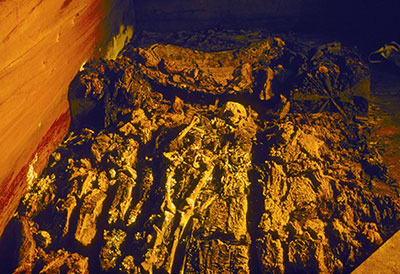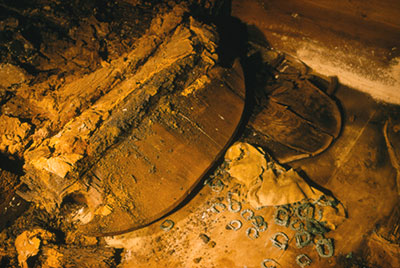For several thousand years, anyone entering the valley of the ancient Sangarius (modern Sakarya) River near the site of Gordion would have noticed the huge mound of earth now called Tumulus MM. Still standing at 53 m (almost 175 feet) tall and on the top of a ridge, it is visible from long distances on every major ancient or modern road. It is one of over 120 tumuli, or burial mounds, around Gordion, but it dominates the others, as it is larger and grander in every way. These mounds typically covered the burial of a single elite person; Tumulus MM surely marked the burial of an important Phrygian king.
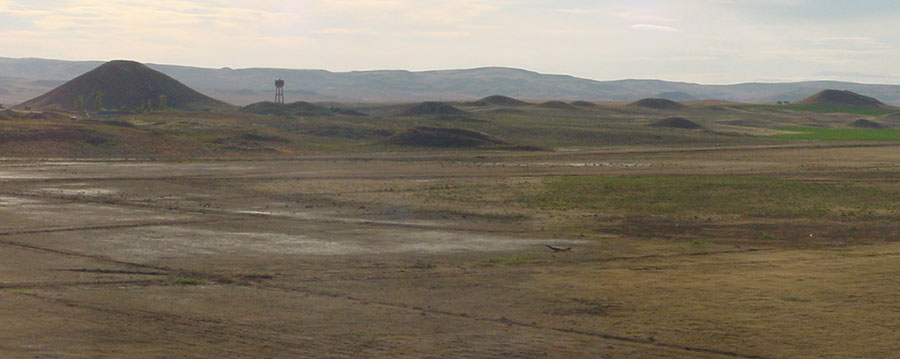
MM stands for “Midas Mound,” after the most famous of the Phyrgian kings, but the most recent dating of the construction of the tomb chamber to ca. 740 BCE indicates that Midas was not buried there, since he appears in Assyrian records as late as 709 BCE. While nothing associated with the tomb identifies the dead king, the date of its construction suggests that the occupant of Tumulus MM was the father of Midas. In that case, this mound was constructed by Midas—the first prominent and public statement of his power and ambition.
Tumuli as Indications of Power
The ancient Phrygians realized the importance of such statements. It is clear to those of us who have worked at Gordion for many years that all the major tumuli in the area, and most of the minor ones, are placed with a direct line of sight to (and from) the city itself, which lay beside the river. In addition, the tumuli are located in valleys and on ridges along ancient roads leading out from the city, thus increasing their visibility and impact. Different sizes of tumuli certainly reflect a hierarchy of scale that must be directly tied to the relative importance of the individual buried in each tumulus. The table below shows some of the Gordion tumuli in descending order by volume.
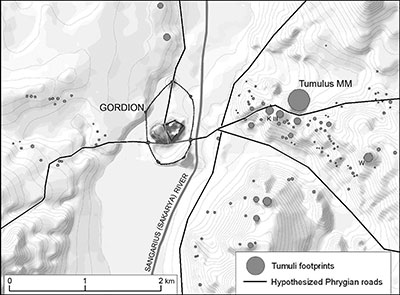
The list begins with Tumulus MM and includes most of the excavated tumuli around Gordion, plus a selection of unexcavated tumuli that are both close to and prominently visible from the city. The excavated tumuli on the list range in date from ca. 850 to 530 BCE. The volumes are calculated using available data and then rounded off. The breakdown into groups is somewhat arbitrary, but it shows the special nature of the largest tumuli at Gordion, which are all included here. Tumulus MM is in a class by itself (#1), nine times larger than the second largest tumuli. The next group (#2) also stands out, as they are about three times the size of the tumuli in class #3. The mean volume drops off by half for class #4, then in fairly dramatic percentages for each of the succeeding groups.
One could assume that the largest tumuli mark the burials of kings, but it should be noted that one of the Class #3 tumuli is Tumulus P, which contained the burial of a young boy, identified as such by the tomb contents. While this individual may have succeeded to the throne as a child and simply died young, he might also have been a young prince in line for the throne who died before his time. The large size of the tumulus might represent the admiration of the boy’s successor or the grief of his loved ones. Tumulus P is a generation or so earlier than MM, so the young prince may have been the older brother of Midas or perhaps his uncle.
| Class | 62 Tumuli | Percent of Total # | Lower Diameter | Height | Approximate volumes in Cubic Meters | Mean Volume |
|---|---|---|---|---|---|---|
| 1 | Tumulus MM | 2% | 300 m | 53 m | 1,250,00 | 1,250,00 |
| 2 | 2 tumuli | 3% | 150 m | 22-24 m | 130,000-140,000 | 135,000 |
| 3 | 3 tumuli | 5% | 95-107 m | 16-18 m | 41,000-50,000 | 44,000 |
| 4 | 5 tumuli | 8% | 74-84 m | 12-15 m | 20,000-25,000 | 22,000 |
| 5 | 5 tumuli | 8% | 68-76 m | 10-12 m | 13,000-18,000 | 15,000 |
| 6 | 11 tumuli | 18% | 53-69 m | 8-10 m | 6,000-10,000 | 8,000 |
| 7 | 15 tumuli | 24% | 35-60 m | 4-7 m | 1,000-5,000 | 3,000 |
| 8 | 8 tumuli | 13% | 21-30 m | 2-4 m | 500-900 | 700 |
| 9 | 12 tumuli | 19% | 16-31 m | 1-3 m | 100-400 | 200 |
Aside from Tumulus MM (ca. 740 BCE), the largest excavated tumuli that may have contained royal burials are Tumulus W (ca. 850 BCE), K-III (ca. 780 BCE), and possibly Tumulus P (ca. 760 BCE). One should assume that at least one unidentified king’s burial, dating between W and K-III, might be found among either the other excavated (but looted) tumuli (X, Y, Q, or S) or among one of the larger unexcavated tumuli.
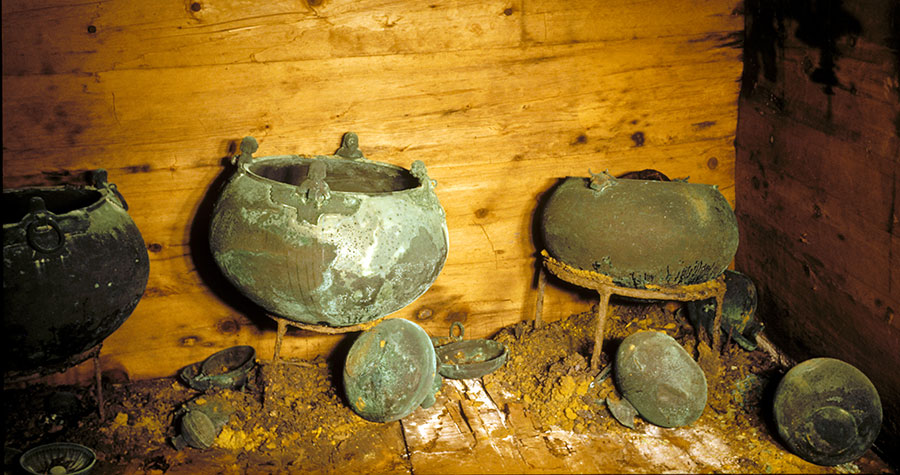
By the time Tumulus MM was being planned, the Phrygians had over 100 years of experience creating wooden tomb chambers covered by tumuli.
The articulation of the skeleton suggests that the body was largely intact when it was buried.
The Construction of Tumulus MM
By the time Tumulus MM was being planned, the Phrygians had over 100 years of experience creating wooden tomb chambers covered by tumuli. Typically, a pit was dug, and then a wooden chamber of pine and/ or juniper was built in the bottom, with rough stones filling the space around the outside of the chamber. e burial was placed inside the wooden chamber, a flat roof was set on top, and then more rough stones were piled on top. Above the stones was a layer of clay, followed by the soil of the tumulus mantle. As the stones and earth were piled up over the tomb chamber, the wooden roof and walls might have started bending and audibly creaking as they took on the ever-increasing weight. The builders may have heard roof beams breaking; all the excavated flat-topped tomb chambers had collapsed roofs, although there is no way to date when that happened.
When it came time to build Tumulus MM, the designer(s) pulled out all the stops: every element was larger and stronger than any tomb before, at least as far as we know from the 44 excavated tumuli at Gordion. The pit was lined with large stone blocks; the wooden walls were doubled, with juniper logs set outside the line of the pine walls of the tomb chamber proper; the roof was double-pitched like the megarons on the Citadel Mound instead of having the usual flat top; and a secondary roof (this time flat) of juniper logs was built over the entire tomb chamber in an apparent effort to keep as much weight as possible off the chamber.
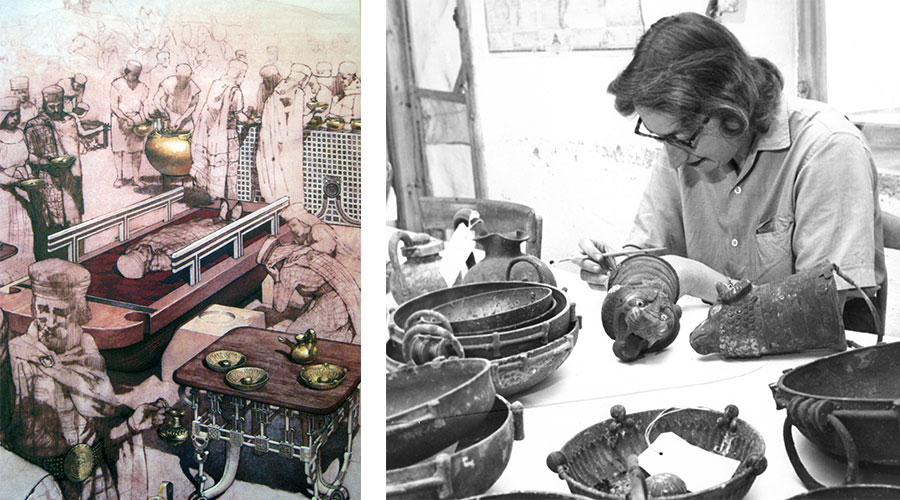
RIGHT: Ellen Kohler cleans and conserves bronzes from Tumulus MM, including the lion and ram-headed situlae. Gordion Archaeological Project.
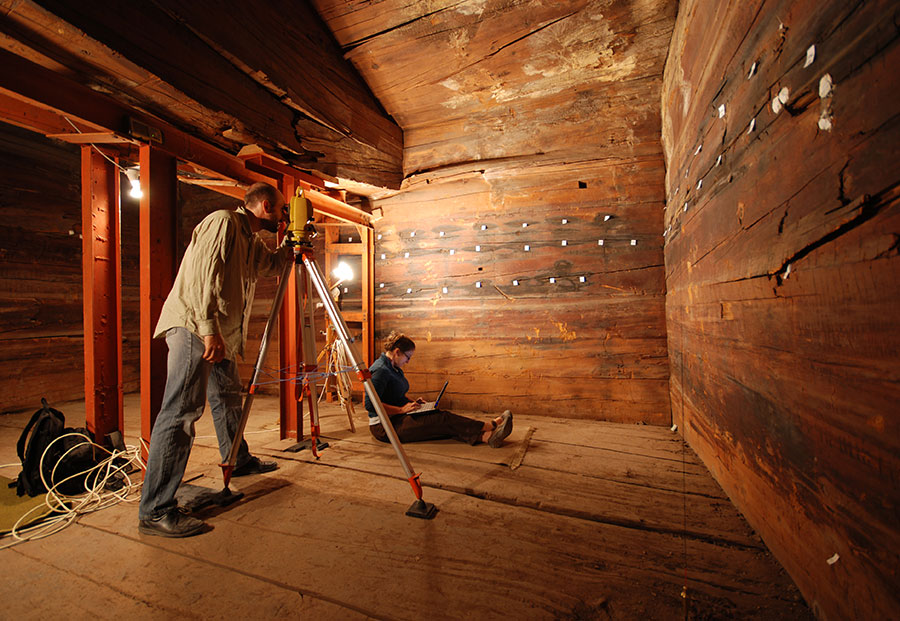
Phrygian engineers were very effective in designing and constructing MM. Even though the wall and ceiling beams bent, cracked, and sagged, they never hit the floor, keeping the tomb chamber intact. Fungus, which under normal circumstances would eat all the wood, died out eventually, after the moisture and temperature levels dropped. Even now, the tomb chamber complex has a cave-like environment, with the temperature staying relatively constant at around 16 degrees C (about 61 degrees F). All we know about the discovery of this remarkable burial comes from Rodney Young’s 1957 excavation. However, we have continued research on aspects of the tomb, such as how it was constructed and events surrounding the burial that was placed inside.
There is no incontrovertible evidence to indicate whether the tomb was built before or at the time of the death of Gordios. In many ancient kingdoms, however, royal tombs were begun while the ruler was still alive. Our current thinking is that the tomb was built in a relatively short period of time, despite Young’s thought that it was built during the dead king’s lifetime, like an Egyptian royal pyramid. It is only the size of MM that elicits such theories, and no one has suggested a similar pre-death construction for any of the smaller tumuli.
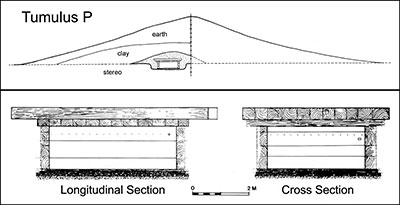
Instead, one must think of the mobilization of the entire available work force, with groups sent out for building materials like large stone blocks or specific sizes of pine beams or juniper logs. Most of the labor went into digging, transporting, and depositing clay and soil for the tumulus mantle (although this mantle may not have been built originally to its full size). It has been estimated that if the Phrygian rulers had a team of 1,000 people working on the construction of the mound, it would have taken over a year and a half to build. One can imagine the entire able-bodied population of Gordion and even the kingdom as a whole brought to bear on this massive effort. Most of the rough stones used in the packing around the tomb chamber were small, so it seems possible that even children took part in this operation.
The Construction Sequence
We are on firmer ground when discussing the construction sequence of the tomb chamber complex. The original pit was filled with rough stone, unworked boulders, and limestone blocks to the approximate original ground level. Then two pairs of juniper logs were set into this fill and trimmed flat on their tops to provide a bearing surface for the cedar floor beams, which overlapped each other to give them more stability. Next, the pine wall beams were laid on top of the floor beams, with a corresponding juniper log laid about 35 cm away from each wall beam.
At the same time, the perimeter wall rose, with the Phrygians using small rough stones to fill the spaces between the outer wall and juniper logs, and between the juniper logs and pine wall beams. Outside the stone perimeter wall, the tumulus rose as well, level by level. When the tomb chamber walls were about 2.65 m high, double-stacked pairs of huge pine cross beams were installed, running beyond the pine walls and onto notches cut in the eighth juniper log of the outer casing at both east and west. e tops of the upper pair of cross beams marked the height of the finished east and west walls at about 3.25 m. e cross beams themselves carried two more pairs (three pairs above the north cross beam) of pine beams that were trimmed at angles of approximately 17 degrees to form a resting surface for the roof beams. Once cleaned up, the tomb chamber was ready for the burial, looking now like a large, rectangular, wood-lined pit in the top of a truncated cone-shaped mound of earth (the partially finished tumulus).

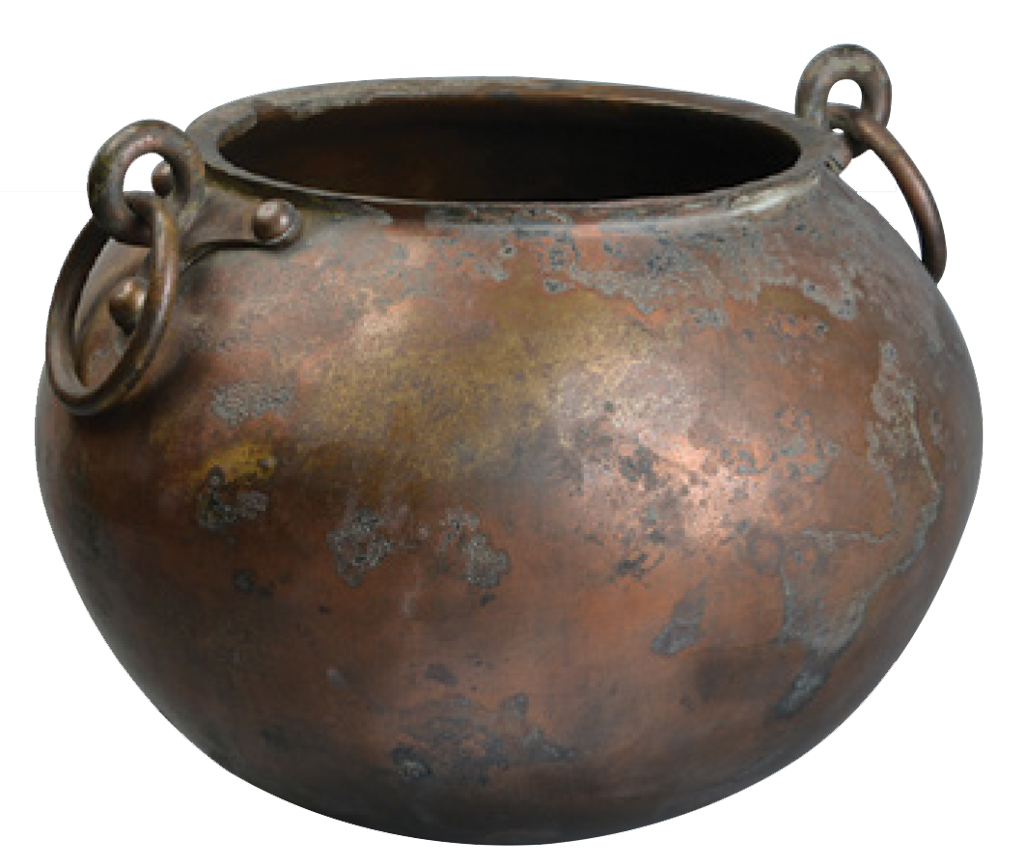
The Funeral and Burial Chamber of the Dead King
The king—dressed in leather and resting on layers of textiles—was probably placed in his cedar coffin before the funeral began. The funerary feast has been reconstructed from remains found in the tomb by Dr. Patrick McGovern (Consulting Scholar, Penn Museum Near East Section). McGovern and a team of researchers analyzed chemical residues from vessels to identify ingredients used in making the ancient food and drink served at the feast. In 2000, this research was used to create a special Midas dinner at the Penn Museum. The main course was roasted sheep or goat stew with lentils and spices. The drink was a somewhat odd-sounding mixture of grape wine, barley beer, and honey mead.
Dr. Patrick McGovern and a team of researchers analyzed chemical residues from vessels to identify ingredients used in making the ancient food and drink served at the feast.
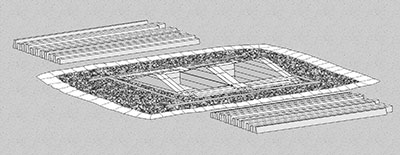
After the funeral proceedings, the body and presumably the most important physical items from the feast were carried to the tomb for lowering into the chamber. The coffin holding the body of the king was set up in the northwest corner of the tomb chamber. A table near the king’s head held a cloth bag containing 145 bronze fibulae (garment pins), with 37 more fibulae found among the remains of the textiles in the coffin. Why were there so many fibulae? A suggestion arose from a discussion about the tomb during the 2015 field season. Perhaps these fibulae did not belong originally to the king at all, but were removed by the funeral guests from their own cloth- ing and set on the coffin as a parting gift to the dead king. Such a large number of fibulae would have been unwieldy; this may have led to them being gathered up and placed in the cloth bag for transport to the tomb.
Two stools and a chair that held textiles—the whole assemblage badly deteriorated—were found in the northeast corner of the tomb chamber. At the center of the east wall were two intricately inlaid wooden serving stands that originally had open-work tops with rings for small round cauldrons (often called dinoi, borrowing a Greek term), which must have been used to serve the stew. To the south of the stands were the remains of an elaborate three-legged table, which was the finest of nine wooden tables found in the tomb. All except the one by the coffin had been loaded with bronze omphalos bowls that were eventually spread over the floor when the tables finally collapsed. Along the south wall were three large bronze cauldrons on iron stands, which originally held the special drink for the banquet, and may have been used in the brewing process itself; each was found with ceramic pots holding food remains from the funeral feast.
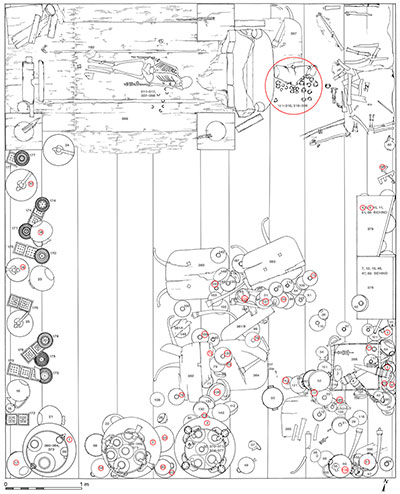
The western floor of the tomb chamber had originally been empty, but, when it was found by Young, it was filled with ten large globular bronze pitchers and the remains of nine sets of large round and rectangular leather pieces covered with sheets of bronze decorated with bronze bosses (possibly ceremonial belts). The rectangular pieces appear to have been attached together horizontally. All of these had originally been suspended on L-shaped iron spikes hammered into the west wall in two rows of ten. Similar rows of spikes were set into the south wall (two rows of twelve) and the east wall (three rows of eight, nine, and eight spikes). It appears that any bronze object with a handle, hook, or other method of suspension was hung on spikes on the walls. The rows of spikes stopped short of the coffin on the west wall and the stools and chair assemblage on the east wall. The objects on the east wall included the bronze dinoi and two bronze ladles used with the serving stands. Above the southern serving stand, two elegant situlae (bucket-shaped vessels) were suspended, one with the head of a lion and the other with that of a ram.
Contemporary Neo-Assyrian reliefs suggest these situlae were used to dip the wine-beer-mead drink out of large cauldrons for serving into bowls. Among other items suspended on the spikes were 15 bowls with swiveling ring handles, larger and heavier than the omphalos bowls from the tables. Three of these had wax pressed onto the rim, into which were scratched inscriptions in Phrygian letters. The longest says, “SITSIDOSAKOR,” which was thought to be a name, Sitsidos, followed by akor, which might be a verb. Phrygian inscriptions are so scarce and short that the language is still poorly understood. There were 100 omphalos bowls found in the tomb, plus the 15 larger bowls, suggesting the possibility of 100 honored guests at the funeral feast, with 15 more who were especially important.
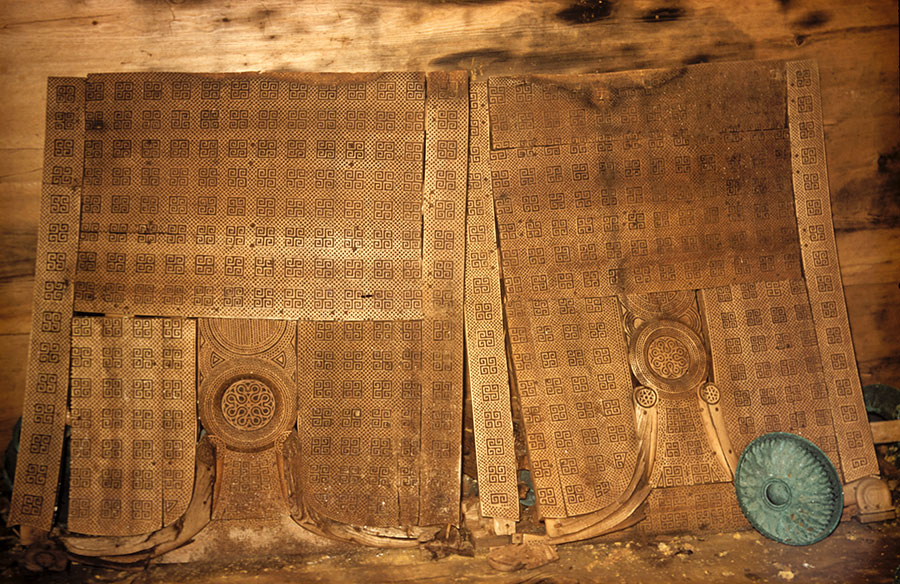
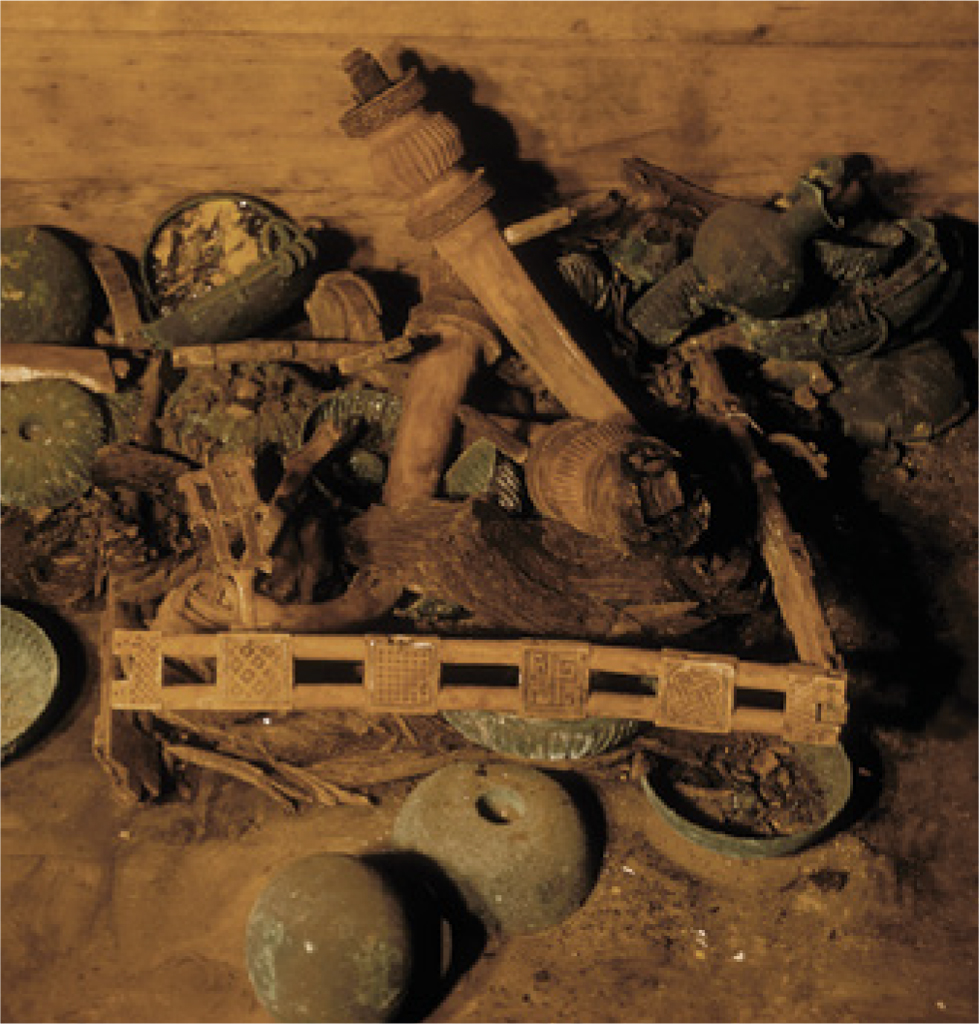

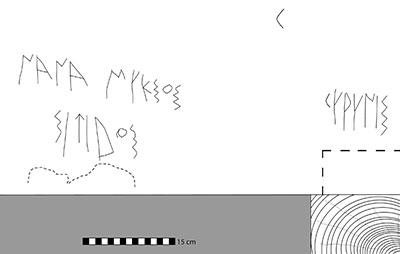
Stealing the Tomb Chamber
With the body and artifacts secure in the tomb, the pine roof beams were set in place and the tomb chamber was closed off completely. A second layer of roof beams covered the first, and then a secondary roof was built above the entire wooden tomb. More rough stone was piled over the top of the tomb chamber complex, and this was in turn covered by the clay and earth of the tumulus, where it remained undisturbed for 2,700 years. In 2007, 50 years after the excavation of Tumulus MM, a chance discovery revealed three Phrygian names inscribed on a roof beam projecting past the gable support outside the northwest corner of the tomb chamber. The names had been hidden in plain sight, high above the floor level of the tomb and all but invisible without proper light. A fourth name or word (“Urunis”) was set further down the beam and now adjacent to another beam, making it clear that the names had been inscribed before the roof beam was set in place by the Phrygian builders after the funeral. The mark in front of “Urunis” may mark the setting position of the roof beam. The first three names are “Nana Myksos Sitsidos.” All four names are written in the same large size by the same hand. Aside from some Phrygian letters at the south end of the same beam, these are the only ancient names or words thus far found on the beams of the tomb. Sitsidos—a name that was inscribed on the bowl mentioned above—is of great interest. If it really is the name of an important guest at the funeral, one has to wonder who this individual was. It is perhaps wishful thinking that he was what modern Turks call the “usta” or master builder at Gordion. This position would certainly have been important in the capital city, given the apparent history of constant building and rebuilding at the site. Sitsidos may have taken the opportunity (surreptitiously?) to sign his name (and those of two companions?) to the first roof beam used to seal the tomb chamber. It might have been a symbolic gesture of pride and closure in a special project that we now know as Tumulus MM. It could have been a last note to his former employer, the king, whose death left a monument for the ages.
RICHARD LIEBHART is Adjunct Assistant Professor of Art History at Elon University in North Carolina. He has been working at Gordion with a focus on Tumulus MM for over 20 years. LUCAS STEPHENS is a Ph.D. candidate in the Graduate Group in Art and Archaeology of the Mediterranean World at the University of Pennsylvania.
For Further Reading
Liebhart, R.F. “Phrygian Tomb Architecture: Some Observations on the 50th Anniversary of the Excavations of Tumulus MM.” In The Archaeology of Phrygian Gordion, Royal City of Midas, edited by C.B. Rose and G. Darbyshire, pp. 128- 147. Philadelphia: University of Pennsylvania Museum of Archaeology and Anthropology, 2012.McGovern, P.E. “The Funerary Banquet of ‘King Midas.” Expedition 42.1 (2000) 21-29.
Simpson, E. The Gordion Wooden Objects. Vol. I, The Furniture from Tumulus MM. Leiden: Brill, 2010.
Young, R.S. Three Great Early Tumuli. Philadelphia: University Museum, 1981.
